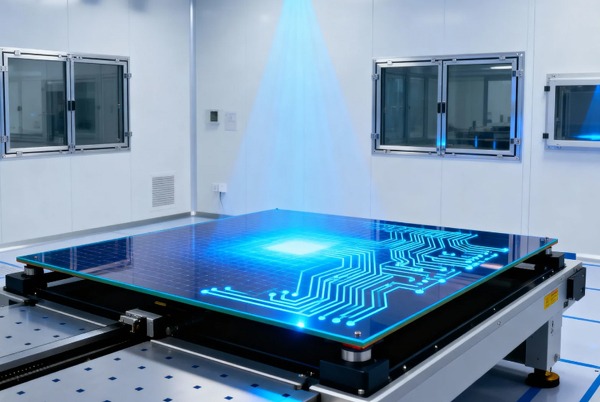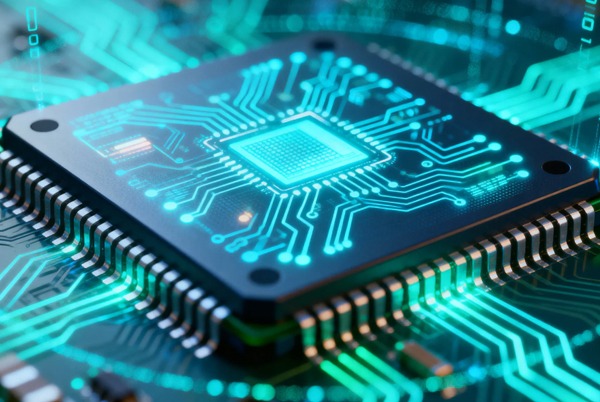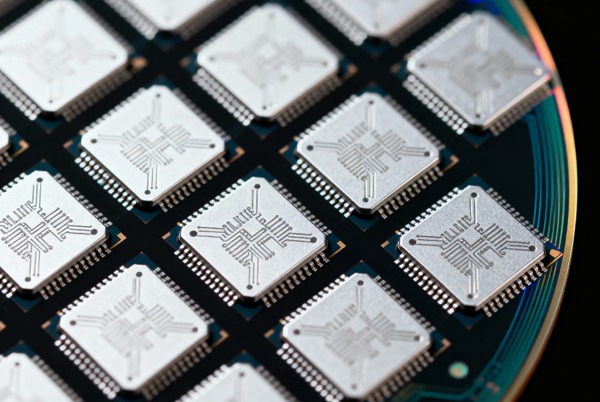Inhaltsübersicht
Was ist ein Integrierte Schaltung?
Eine integrierte Schaltung ist ein miniaturisiertes elektronisches Bauteil, das unter Verwendung spezifischer Halbleiterprozesse hergestellt wird und elektronische Komponenten wie Transistoren, Widerstände, Kondensatoren, Diodenund ihre Verbindungswege auf einem einzigen Halbleiterwafer oder dielektrischen Substrat. Diese Komponenten sind strukturell zu einem vollständigen Ganzen geformt und bilden nach der Verpackung eine Miniaturstruktur mit spezifischen Schaltkreisfunktionen.
Äußerlich sieht ein integrierter Schaltkreis in der Regel wie ein kleiner, verpackter Block mit mehreren Pins aus, doch im Inneren verbirgt sich ein unglaublich komplexer Mikrokosmos. In Schaltplänen werden integrierte Schaltkreise normalerweise durch Symbole wie „IC” oder „N” dargestellt.
Wie funktionieren integrierte Schaltkreise?
Grundlegende Funktionsprinzipien
Die Grundlage für den Betrieb integrierter Schaltkreise liegt in Halbleitereigenschaften und das Prinzip der ElektrofeldsteuerungEinfach ausgedrückt verarbeiten, speichern und übertragen sie Informationen, indem sie die Schaltzustände von Millionen oder sogar Milliarden von Transistoren innerhalb des Chips steuern.
Kern-Workflow:
- SignaleingangExterne elektrische Signale gelangen über Eingangsstifte in die integrierte Schaltung.
- Interne VerarbeitungDie Transistoren im Chip verstärken, berechnen oder wandeln die Signale entsprechend der vorgesehenen Logik um.
- ErgebnisausgabeDie verarbeiteten Signale werden über Ausgangspins an andere Schaltungskomponenten übertragen.
Verständnis der hierarchischen Struktur
Um integrierte Schaltkreise besser zu verstehen, können wir eine hierarchische Top-Down-Struktur verwenden:
- Systemebene: Komplettes elektronisches Gerätesystem (z. B. ein Smartphone)
- ModulstufeFunktionsmodule innerhalb des Systems (z. B. Energieverwaltung, Signalverarbeitung)
- Register-Transfer-Ebene (RTL)Bestehend aus Registern und kombinatorischen Logikschaltungen
- Gate-EbeneGrundlegende Logikgatter-Schaltungen (UND-, ODER-, NICHT-Gatter usw.)
- TransistorebeneDie grundlegendsten Halbleiter-Schalteinheiten
Transistoren: Die Kernelemente integrierter Schaltkreise
Transistoren sind die grundlegenden Bausteine integrierter Schaltkreise und lassen sich hauptsächlich unterteilen in:
- Bipolare Transistoren (BJT): Wird häufiger in frühen Phasen verwendet, mit höherem Stromverbrauch
- Metalloxid-Halbleiter-Feldeffekttransistoren (MOSFET): Mainstream in modernen ICs, geringer Stromverbrauch, hohe Integrationsdichte
Durch die Kombination von Transistoren zu verschiedenen Logikgattern und die anschließende Verbindung dieser Logikgatter zu komplexen Schaltkreisen mittels mehrschichtiger Verbindungstechnik werden letztlich leistungsstarke Verarbeitungsfähigkeiten erreicht.

Klassifizierungssystem für integrierte Schaltungen
Klassifizierung nach Funktion und Struktur
- Analoge integrierte Schaltungen: Kontinuierlich variierende analoge Signale verarbeiten
- Digitale integrierte Schaltungen: Diskrete digitale Signale verarbeiten
- Mischsignal-integrierte Schaltungen: Verarbeiten Sie analoge und digitale Signale gleichzeitig.
Klassifizierung nach Integrationsgrad
- SSICKleinteilige Integration (10–100 Komponenten)
- MSICMittlere Integration (100–1.000 Komponenten)
- LSICGroßintegrierte Schaltungen (1.000–10.000 Komponenten)
- VLSIC: Sehr große Integration (10.000–100.000 Komponenten)
- ULSIC: Ultra-Large-Scale Integration (100.000 bis 1 Million Komponenten)
- GSICGiga-Scale-Integration (über 1 Million Komponenten)
Klassifizierung nach Anwendungsbereich
- Allzweck-integrierte SchaltungenStandardschaltungen, die für verschiedene Anwendungen geeignet sind
- Anwendungsspezifische integrierte Schaltungen (ASIC): Für spezifische Anwendungen maßgeschneiderte Schaltungen
- System auf einem Chip (SoC)Integriert komplette Systemfunktionen auf einem einzigen Chip.
Herstellungsprozess von integrierten Schaltkreisen
Die Herstellung integrierter Schaltkreise ist einer der komplexesten industriellen Prozesse, die derzeit zum Einsatz kommen. Die wichtigsten Schritte umfassen:
- Wafer-Vorbereitung: Schneiden von hochreinen Siliziumzylindern in dünne Wafer
- Oxidation: Bildung einer Siliziumdioxid-Isolierschicht auf der Waferoberfläche
- Fotolithografie: Übertragung von Schaltungsmustern auf den Wafer mithilfe von Fotolithografie-Maschinen
- ÄtzenEntfernen von überschüssigem Material zur Bildung von Schaltungsstrukturen
- Ionenimplantation: Veränderung der elektrischen Leitfähigkeit von Silizium
- Metallisierung: Verbindungsdrähte hinzufügen
- Prüfung und Verpackung: Testen der Chipfunktionalität und Anbringen einer Schutzverpackung
Dieser Vorgang muss Dutzende Male wiederholt werden, um komplexe dreidimensionale Strukturen im Nanobereich aufzubauen.
Verpackungsformen für integrierte Schaltkreise
Die Verpackung schützt nicht nur den Chip, sondern stellt auch Verbindungen zu externen Schaltkreisen her:
- SOP: Small Outline Package, Pins in Form von Flügeln
- PGAPin Grid Array, häufig für Mikroprozessoren verwendet
- BGABall Grid Array, hochdichte Pin-Anordnung
- DIPDual In-line Package, traditionell und weit verbreitet

Technische Eigenschaften und Vorteile integrierter Schaltkreise
- Miniaturisierung: Komprimiert komplexe Schaltkreise auf extrem kleinen Raum
- Niedrige KostenDie Massenproduktion senkt die Stückkosten erheblich.
- Hohe LeistungKurze Signalübertragungswege ermöglichen hohe Betriebsfrequenzen.
- Geringer Stromverbrauch: Modernes IC-Design legt Wert auf die Optimierung der Energieeffizienz.
- Hohe VerlässlichkeitReduzierte externe Verbindungspunkte erhöhen die Stabilität.
Anwendungsbereiche integrierter Schaltungen
Integrierte Schaltkreise haben jeden Bereich der modernen Technologie durchdrungen:
- UnterhaltungselektronikSmartphones, Fernseher, digitale Produkte
- ComputersystemeCPUs, Speicher, Speicher-Controller
- Kommunikationsausrüstung: Basisstationschips, Netzwerkprozessoren
- Industrielle SteuerungSensoren, Automatisierungssteuerungen
- Kfz-ElektronikMotorsteuerung, Sicherheitssysteme
- Medizinische AusrüstungDiagnosegeräte, implantierbare Geräte
- Militär und Luft- und RaumfahrtRadar, Navigation, Kommunikationssysteme
Zukünftige Entwicklungstrends
Da Moores Gesetz allmählich an seine physikalischen Grenzen stößt, bewegt sich die Technologie der integrierten Schaltkreise in neue Richtungen:
- 3D-IntegrationErhöhung der Integrationsdichte durch vertikale Stapelung
- Anwendungen für neue MaterialienErforschung neuer Materialien wie Kohlenstoffnanoröhren und Graphen
- Heterogene IntegrationIntegration von Chips aus verschiedenen Prozessen in einem einzigen Gehäuse
- Quantencomputing: Völlig neue Berechnungsparadigmen auf der Grundlage der Quantenmechanik
- Neuromorphes RechnenChipdesigns, die die Funktionsweise des menschlichen Gehirns nachahmen
